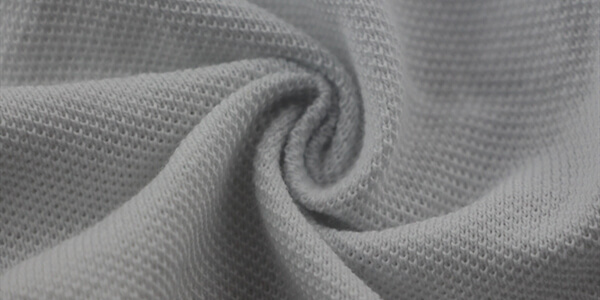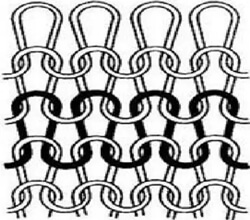
Explorando los diversos estilos de tejidos de punto
Tejer es una forma de manipulación del hilo en la que los bucles se entrelazan para crear telas o textiles. Este tipo de tela consta de filas horizontales conocidas como hileras y filas verticales denominadas columnas. Los tejidos de punto se utilizan en varios artículos cotidianos, desde ropa hasta ropa de cama.
El proceso de tejer requiere una manipulación cuidadosa de los bucles de hilo. Para crear la tela, uno debe llevar a los bucles consecutivos a través del bucle de una fila anterior. Esta acción entrelazada forma una serie de bucles conectados que producen el material tejido.
Las telas tejidas son famosas por la ropa, las mantas y otros artículos que requieren calor o flexibilidad. El tejido es solo un tipo de estructura de tela; Las telas tejidas, no tejidas y trenzadas también son estándar. Cada uno tiene su aspecto, ventajas y desventajas distintas. El tipo de tela que seleccione depende de lo que esté creando y desee el resultado. Conocer los diferentes tipos de materiales disponibles puede ayudarlo a tomar una decisión informada.
1. Tejidos de punto de trama
Los tejidos de punto de trama generalmente se componen de varias materias primas, como hilo de algodón, hilo mezclado, seda de poliéster de baja elasticidad o seda de poliéster de forma particular, seda de nylon, hilo de algodón, hilo de lana y seda spandex. Estos materiales se tejen utilizando varios métodos, incluida la organización de puntada simple (que contiene punto básico, cambio de puntada simple, tejido acanalado simple y tejido simple acanalado doble), organización de jacquard y organización de círculos de lana. La elasticidad, la suavidad, la resistencia a las arrugas y la textura tipo cabello son características estándar de las telas tejidas por trama. El tejido de punto de trama de algodón tiene buena absorción de humedad y permeabilidad al aire; sin embargo, el material no es crujiente y es propenso a arrugarse y aflojarse. Por otro lado, es más probable que el tejido de punto de fibra química tenga pelusa, bolitas o seda con ganchos.

Las principales categorías de tejidos de punto de trama son las siguientes:
Tejido de punto de poliéster
Esta tela se adapta a la ropa de hombres, mujeres y niños. Es un material altamente resistente al desgaste y alástico con un gran atractivo visual. Tiene una estructura compacta y gruesa, lo que lo hace ideal para chaquetas, trajes, ropa deportiva, ropa de yoga, ropa al aire libre, rompientes de viento, chalecos, faldas y otras prendas. La tela presenta colores brillantes y texturas nítidas que se asemejan a los estilos de tweed de la tela de lana. La coordinación del color es armoniosa, y los detalles de tejido son claros y distintos.
Tejido de punto de algodón
Una opción popular en muchos tipos de ropa y accesorios. Se puede encontrar en prendas como camisetas, ropa interior, ropa casual, chaquetas, trajes, gabardinas e incluso ropa para niños. Este tipo de tela es conocido por su textura suave y su sensación regordeta. También tiene una buena elasticidad y la capacidad de retener la calidez. Los tipos populares de tela de algodón tejido incluyen tela lisa, tela de sudor, algodón mercerizado, tela de sudadera, capa de aire, tela romana y tela de doble cara. Estas telas son de excelente calidad, lo que las hace ideales para varias prendas de vestir.
Tejido de punto de algodón con cubierta de poliéster
La tela, elaborada a partir de una mezcla de poliéster y algodón, es ideal para crear camisas, chaquetas y ropa activa. Sus fibras resistentes a las arrugas lo hacen increíblemente fácil de cuidar, y su composición resistente al desgaste permite un uso duradero. También es muy transpirable, lo que lo hace cómodo cuando se usa contra la piel. Además, es suave al tacto, lo que lo convierte en una excelente opción para las prendas. La tela también se tiñe en una variedad de colores y tonos.
Tejidos de fibra de celulosa reciclada
Son una opción popular para la ropa e incluyen tela Tencel, tela modal, tela de fibra de bambú, tela de viscosa y tela de amoníaco de cobre. Estas telas son suaves, con buenas propiedades de retención de calor y alto brillo. Las prendas de punto como camisetas, ropa interior, leggings y faldas a menudo están hechas de estas telas. Sus cualidades livianas pero duraderas los convierten en una excelente opción para el uso diario. Varios materiales permiten a los diseñadores crear un aspecto único para adaptarse a cualquier estilo u ocasión. Las telas de fibra de celulosa reciclada se pueden lavar y mantener fácilmente para mantener las prendas para ver nuevas en los próximos años. Estas telas pueden proporcionar una apariencia y sensación de lujo con la atención adecuada. También son más amigables con el medio ambiente que las telas tradicionales, lo que las convierte en una opción cada vez más popular para los consumidores conscientes de la moda.
2. telas tejidas
Las telas de unión de urdimbre generalmente están hechas de materiales de filamentos sintéticos como poliéster, nylon, vinilón y polipropileno. Alternativamente, pueden construirse con fibras naturales como algodón, lana, seda o cáñamo mezclados con fibras químicas. Este tipo de tela proporciona una buena estabilidad longitudinal, una sensación nítida y menos dispersión. La permeabilidad al aire también es buena, pero su extensión lateral, la elasticidad y la suavidad son más débiles que las telas de ida y vuelta.
Las telas con un patada de urdimbre son altamente duraderas e ideales para textiles técnicos y médicos, ropa protectora e interiores automotrices. El tejido de urdimbre tiene muchas aplicaciones prácticas en la industria textil debido a sus características únicas. Se usa comúnmente para hacer lencería, calcetines, cintas decorativas, adornos, trajes de baño y tapicería. También se usa como refuerzo en productos de caucho como neumáticos y mangueras.
El tejido de urdimbre es mucho más rápido que el tejido de la trama porque no requiere reinsertar el hilo en la tela tejida. Esto significa tiempos de producción más cortos y ahorros de costos para los fabricantes, lo que hace que el tejido de urdimbre sea una elección popular para la producción a gran escala. Los materiales también se pueden manipular para crear patrones complejos con más control que otros tipos de tejido de punto. El tejido de urdimbre se ha vuelto esencial en muchas industrias, y los avances tecnológicos continúan conduciendo a nuevas posibilidades.
Las principales categorías de telas de punto de urdimbre son las siguientes:
Tela con un patinio de poliester
Una opción popular para la ropa debido a su textura plana y colores brillantes. Por lo general, viene en dos pesos; delgado y grueso. Las telas ligeras con un punto de guerra de poliéster a menudo se usan para hacer camisas y faldas, mientras que los materiales medianos y gruesos se pueden usar para otras prendas como chaquetas, abrigos, trajes, pantalones y más.
Firmación de tela de pila tejida.
Esta tela se usa comúnmente para producir prendas de invierno como abrigos para hombres y mujeres, gabardinas, chaquetas y pantalones. Tiene una cortina agradable, es fácil de lavar, se seca rápidamente y se puede planchar. Sin embargo, es propenso a la acumulación estática y puede atraer fácilmente el polvo.
Además, cuando se usa con otras telas como la lana o el acrílico, su propiedad estática aumenta, atrayendo más polvo. Para reducir esto, se pueden aplicar acabados antiestáticos especiales a la tela. Esto ayuda a protegerlo de la suciedad y el polvo, haciendo que el material sea más duradero y más fácil de limpiar.
En conclusión, la tela de pila con un patio de urdimbre es ideal para prendas de invierno debido a su capacidad superior, fácil lavado, secado rápido y su capacidad de plancha. Cabe señalar que es susceptible a la acumulación estática y de polvo y, por lo tanto, requiere un acabado antiestático especial u otros tratamientos para reducir esto.
Tela de malla con cucharada
La tela de malla con una textura delgada y una excelente elasticidad presenta un toque suave y suave. También cuenta con una excelente permeabilidad al aire, ideal para ropa de verano como camisas para hombres y mujeres. Su naturaleza versátil lo convierte en una elección popular entre los diseñadores de moda y los consumidores.
Tela de terciopelo
La superficie de la tela de terciopelo con udito de urdimbre es gruesa y lujosa, lo que la hace increíblemente suave. Su elasticidad y capacidades de retención de calor lo convierten en una opción ideal para la ropa de invierno y la ropa para niños. Es un material lujoso que proporciona calidez, comodidad y clase. Su pila gruesa agrega una textura agradable a cualquier prenda. Por lo tanto, se está volviendo cada vez más popular por su versatilidad y elegancia. Ya sea que esté buscando un acogedor abrigo de invierno o un elegante vestido de fiesta, esta tela hará una declaración. Su suntuosa textura y su lujosa sensación lo convierten en la elección perfecta para cualquier ocasión.
Tecnia de bucle de punto de guerra.
Esta tela tiene una consistencia completa y gruesa, gracias a su cuerpo de tela sólido pero flexible. Es elástico, absorbe bien la humedad y proporciona una buena calidez. Se caracteriza por una estructura de bucle estable y una deseabilidad superior y se usa principalmente para ropa deportiva, camisetas de solapa, pijamas y ropa para niños. Su versatilidad lo convierte en una opción popular para muchas aplicaciones de ropa.
Las telas de punto están hechas de varios materiales, incluidas fibras naturales como algodón, cáñamo, seda y lana, y fibras sintéticas como acrílico, poliéster y spandex. Tales telas cuentan con buena elasticidad, absorción de humedad, calidez y comodidad. Tienen una amplia variedad de patrones, colores y texturas. Las telas tejidas se pueden clasificar de acuerdo con el tejido, el teñido, el acabado y otros métodos de procesamiento. Cada tipo de tela tiene sus características únicas. Por lo tanto, los materiales de punto se pueden usar para varios tipos de ropa para hombres, mujeres y niños.

